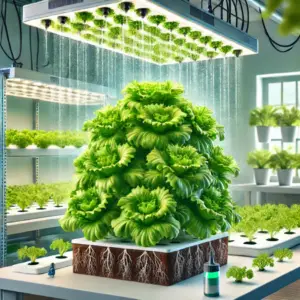
Aeroponics, a soilless method of growing plants where roots are suspended in air and misted with nutrient-rich water, offers numerous advantages over traditional gardening.
Among these advantages are faster growth rates, higher yields, and efficient use of water and nutrients.
For beginners, choosing the right vegetable to start with can make the aeroponic gardening experience both enjoyable and successful.
In this article, we’ll explore the easiest vegetable to grow in an aeroponic system and provide tips to ensure a bountiful harvest.
Why Choose Aeroponics?
Before diving into the easiest vegetable to grow, it’s important to understand why aeroponics is a great choice for gardening:
-
Increased Growth Rate: Plants often grow faster in aeroponic systems due to enhanced oxygenation of the roots.
-
Efficient Resource Use: Aeroponics uses up to 90% less water than traditional soil gardening.
-
Space-Saving: Ideal for urban environments, aeroponics allows for vertical stacking of plants, maximizing limited space.
-
Reduced Pests and Diseases: The absence of soil reduces the risk of soil-borne pests and diseases.
The Easiest Vegetable for Aeroponics: Lettuce
Lettuce is widely regarded as the easiest vegetable to grow in an aeroponic system.
Its fast growth rate, minimal nutrient requirements, and ability to thrive in a controlled environment make it an ideal choice for both beginners and experienced gardeners.
Why Lettuce?
Fast Growth Rate
Lettuce has a remarkably quick growth cycle. From seed to harvest, it typically takes about 3-4 weeks, allowing for multiple harvests throughout the growing season.
Minimal Nutrient Requirements
Lettuce requires a relatively simple nutrient solution, making it easy to manage even for those new to aeroponics.
It thrives on a balanced nutrient mix that is readily available from most hydroponic suppliers.
Versatility
There are numerous varieties of lettuce, including romaine, butterhead, and leaf lettuce, each with slightly different textures and flavors.
This versatility allows you to grow a variety of lettuce types in the same system, providing a diverse harvest.
Setting Up Your Aeroponic System for Lettuce
Choosing the Right System
Investing in a high-quality aeroponic system is crucial for success.
The Lettuce Grow Farmstand is an excellent option for beginners.
It is designed to provide optimal conditions for plant growth, including efficient nutrient delivery and proper root aeration.
Seed Selection
Choose high-quality lettuce seeds from a reputable supplier. Ensure that the seeds are fresh and free from damage.
Varieties like romaine and butterhead are particularly popular for aeroponic systems due to their robust growth and delicious flavors.
Germination
While lettuce seeds can be planted directly into the aeroponic system, starting them in a seed tray can improve germination rates.
Once the seeds have sprouted and developed their first true leaves, they can be transplanted into the aeroponic system.
Nutrient Solution
Prepare a balanced nutrient solution specifically designed for leafy greens.
Regularly monitor the nutrient levels and pH of the solution to ensure optimal growth. Lettuce typically prefers a pH range of 5.5 to 6.5.
Lighting
Adequate lighting is essential for lettuce growth.
If growing indoors, use high-quality grow lights such as those from GrowAce.
Ensure the plants receive 12-16 hours of light per day for optimal growth.
Environmental Control
Maintaining the right temperature and humidity levels is crucial.
Lettuce thrives in temperatures between 60-70°F (15-21°C).
Use fans to ensure good air circulation and prevent mold or mildew.
Caring for Your Lettuce Plants
Regular Monitoring
Check your lettuce plants daily to monitor their growth and health.
Look for signs of nutrient deficiencies or pest infestations and address them promptly.
Pruning and Harvesting
Prune any damaged or yellowing leaves to encourage healthy growth.
Harvest lettuce when the leaves are large enough to eat but before they become too mature and bitter.
With continuous harvesting, you can enjoy fresh lettuce throughout the growing season.
Cleaning and Maintenance
Regularly clean the aeroponic system to prevent algae and bacteria buildup.
Ensure that all components, including the nutrient reservoir and misting nozzles, are functioning correctly.
To Sum it Up
Lettuce is undoubtedly the easiest vegetable to grow in an aeroponic system.
Its fast growth rate, minimal nutrient requirements, and versatility make it an ideal choice for beginners.
By choosing a high-quality system like the Lettuce Grow Farmstand and using reliable grow lights from GrowAce, you can ensure a successful and bountiful harvest.
Happy growing!
